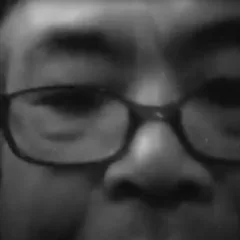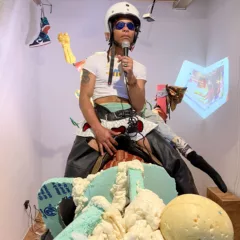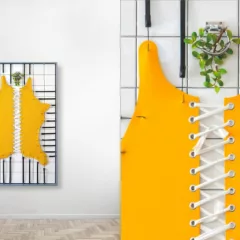Forget the summer doldrums of art. It was nowhere to be seen in the crush of people at Vox Populi Friday for its opening of Vox VI, the sixth of its annual emerging artist exhibitions held after the slew of MFA shows that mark the spring.
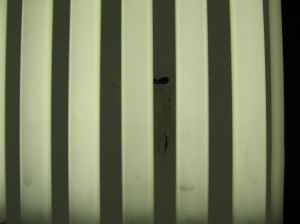
This show has often been a moment of clarity, and this year’s exhibit, juried by ultra-hot New York artists William Powhida and Jennifer Dalton, is among the best of them. In this one, a lot of the pieces relate to a yearning for what is unattainable, and that seems to be pretty close to what everyone is thinking about in these dark days of the gulf oil spill, financial meltdown and continuing war.
My personal favorite is a diptych of fluorescent lights arrayed like jail bars in front of a pair of egg-shaped cells embedded in the wall. Inside one cell stands a flustered white taxidermy bird wearing shades; inside the other, a sleek, gold-trimmed moon landing module that suggests Cinderella’s coach (it’s made of an ostrich egg!). Downstairs in Marginal Utility Gallery, the artist, Aidan Rumack, introduced himself to me and told me his intent was religious. But the RayBans on the holy bird don’t fly as gear for the Trinity. Maybe, just maybe, the spacecraft cries out sci-fi beatification. But fluorescents are so humdrum. And in art historical terms, I’m channeling Dan Flavin optics and Minimalist grids of a man-made version of perfection, not Barnett Newman zips or Mark Rothko orgasms of color-soaked enlightenment. Rumack is a PAFA MFA.
Deidra Krieger, Spastic Plantastic, video
Deidra Krieger sets up a transgressive relationship with the camera and the viewer, while mocking the worlds of advertising and consumerist waste in both of her videos. She’s in your face and beyond your reach all at once. A constant crowd of gallery goers Friday stopped for a while in front of Krieger’s videos and Texas artist Joshua Bienko’s rap videos about art. Lindsay Foster (the one international artist, with a Norway address) transgresses class and propriety in her video, Father Lover Friend, of a California road trip stripped of glamour as she searches with a boy friend for her father, the guide of her quest an old bum. At least that’s what I think is going on. The ambiguity pushes this all into a dangerous zone.
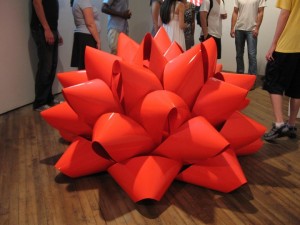
Piper Brett‘s neon phone number is a poignant advertisement of the promise of a relationship or a phone connection. Her giant, Koonsian metal bow also feels personal in a way that Koons doesn’t. The bow promises something that probably can’t measure up to the packaging; it’s installed next to Bienko’s trompe l’oeil paintings of Koons sculptures painted on the soles of a pair of kick-ass shoes. Crushes and desire also get a workout in Constanze Pirch‘s typography-inspired and hunk-inspired Yes, Yes…26 Times Yes! At first I thought the names–from Orlando to Viggo–might all belong to movie stars, but now I realize they are random objects of desire.
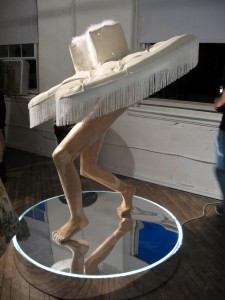
And speaking of desire, Venus de Milo lost her arms, but Sanford Mirling’s sculpture takes it a step farther and loses the top half of his carved female. He crowns her at the waist with a white tutu that looks like a quilted lounge banquette emitting suggestive plumes at its center. Poised atop a mirror, this fantasy requires Dr. Freud. But mama mia, what an object!
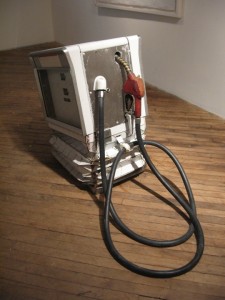
A sad sack gas pump by Jordan Griska is from the good old days, when oil wasn’t all over the gulf and a man was still a man, a car was still a sex symbol. Griska has been busy this year, with a great show at EKG. He’s also in Montana’s post yesterday on a pop-up art show in the Rittenhouse Square area.
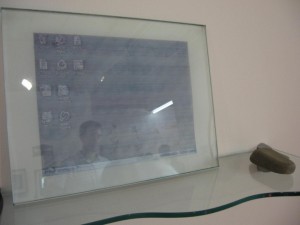
Vox VI also has a couple of pieces about computers (coincidentally perhaps both by Brooklyn-based artists), which are surely desirable. Joshua Weibley‘s conceptual Untitled (Personal Desktop Environment), is a computer for Barney Rubble–the mouse is a rock, and the screen is an ink on paper rendering of a color-separated computer screen image would make George Seurat proud.
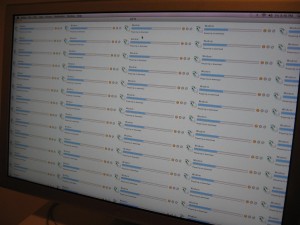
In contrast, Kelli Miller filled a computer screen with animated a series of gif assemblages that make a mockery of us as we stare at the gifs in motion. My personal favorite image is the more than 50 download progress bars that worm across the screen all at once.
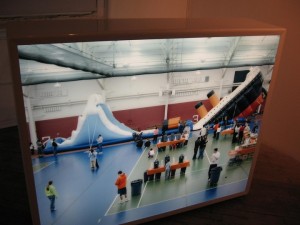
Massachusetts artist Clint Baclawski‘s giant backlit inkjet prints mounted on sleek lightboxes captures real events of improbably scaled razzle-dazzle and excess. Jeff Wall’s staged photos look almost real. Baclawski’s real photos look almost staged. But what is also notable here is the sleek presentation; the lightboxes are high-tech-looking things of beauty in and of themselves.
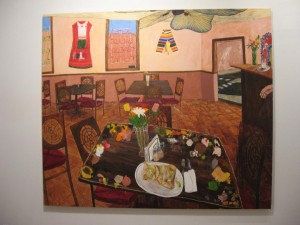
And last but not least, I have to mention Dustin Metz‘s idyllic painting Que Chula Es Puebla. At least someone has found the good life! But there’s no one there, except a disembodied hand.
We’re still living in a time of diminishing prospects where fulfillment remains a wish, and that’s what this show communicates, by in large.
By the way three of the artists in this show are also in the show we juried into the Bambi Biennial–video artist Matt Kalasky, landscape artist Susan Marie Brundage, and Sarah Knouse. Others in the exhibit are Derya Altan, Sally Dennison, Lauren Dombrowiak, Amber DuBois, Katelyn Greth, Megan Hays, Jim Jeffers, Janet Macpherson, Erin Murray, Nightmare City, Manuel Pena, E. Elizabeth Peters, Nora Salzman, Libby Saylor, Samantha Simmons, and Sheila Whitsett. Most of the people who I didn’t mention were equally deserving of some notice.
The exhibit will remain up through Aug. 1, 2010



